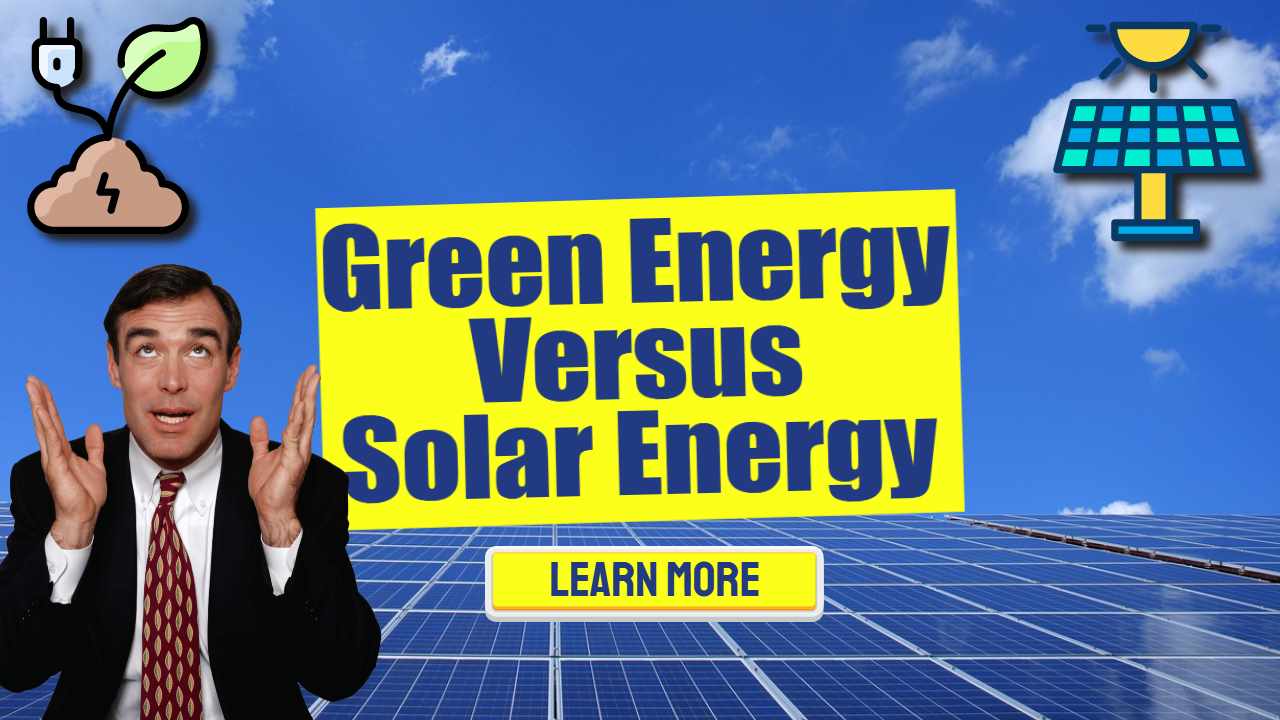Some individuals want to compare green energy to solar energy, which is difficult to respond to without first rectifying a potential misunderstanding. The common misperception is that green energy is not the same as solar energy. However, solar energy is only one of the sustainable “green” energy sources, which we define as renewable energy.
Now, we will answer the topic of green energy vs solar energy by first describing what green energy is and what solar energy is, then comparing the primary categories of green energy with the sort of green energy commonly referred to as solar energy, meaning solar panel derived energy (photovoltaic energy or PV).
What are the Main Green Energy Sources?
Green energy is energy produced from renewable resources such as geothermal heat, sunshine, rain, and waves. It is clean, ecologically friendly, and a fantastic way to assist the environment. But what exactly is it, and how can we use it to our advantage?
Let's take a quick look at each of them, their differences and similarities, and how they individually contribute to the transformation of energy as we know it.
Energy from Biowaste
Green energy and green electricity are phrases that are commonly used interchangeably. This is typically produced as a byproduct of biowaste anaerobic digestion. Biowaste may comprise everything from manure to food waste, as well as agricultural waste such as straw and rice husks.
There is lots of space for further biogas generation because the range of biowastes available is huge and generally unexplored. The raw biogas is cleaned further to become biomethane. According to this article: https://blog.anaerobic-digestion.com/biomethane-plant-advantages/ When appropriately adjusted and tuned engines are used, biomethane may be used as a fuel to replace natural gas (a fossil fuel) and can feed classic reciprocating engines such as vehicles, trucks, and buses.
Here are a few examples of renewable energy:
Geothermal
Geothermal energy is stored energy deep within the ground. It has long been used for bathing and has the ability to generate ten times the amount of power that coal does. Although drilling is required for geothermal energy, this natural resource may produce more than enough energy to power a turbine. In addition to being environmentally friendly, geothermal energy may be a major resource when properly exploited.
Hydropower
The generation of electricity from naturally existing water sources, such as hydroelectric dams and river and tidal barriers, is known as hydropower. It is green energy that may be produced on a massive scale.
Wind Energy
Wind turbines and windmills both provide wind power as a renewable energy source and may be used to power everything from a single home or mill to an entire neighbourhood or town.
Wind energy is unquestionably environmentally friendly. However, it is not available to everyone. Many regions are not extremely windy, in contrast to light, which is present everywhere. The wind is required for turbines to function. However, when combined, these two sources may offer an abundance of energy to a metropolis.
Wind energy is technically a kind of solar energy. When the sun's rays heat the Earth's uneven surface, hot air rises and cold air descends. The wind supplies kinetic (motion-based) energy as a result of this fluctuation in air pressure.
Municipal Solid Waste Energy (EfW)
It is also feasible to gather and burn heat from domestic and business waste products to create power. In many cities, this is done within massive structures. These are known as ERFs (Energy Recycling Facilities), which were probably just known as Council Incinerators until recently.
Energy from Biomass
This is the energy produced by the combustion of wood and charcoal. It emits carbon dioxide in the same way that any other energy recovery technology does, however, scientists do not include CO2 emissions from this source when assessing carbon emissions as a greenhouse gas source. This is because the carbon dioxide emitted by burning wood is expected to be eliminated rather quickly when the forest or woodland regrows and tree growth is renewed.
Geothermal
While geothermal is particularly successful in areas where it is easily accessible, wind and biomass are good for other sites. Wind and solar may be more suited to your individual demands depending on your region. Green energy has the potential to eventually replace fossil fuels. Its flexibility and inexpensive cost make it an appealing solution for a wide range of businesses.
Solar and geothermal energy are practically planets apart. They do, however, have more similarities than differences. After all, they are two of the most environmentally friendly renewable energy sources accessible today.
Geothermal energy originates deep down and manifests as thermal energy or heat.
Green Energy's Advantages
Green energy has several advantages, including cheaper costs and greater energy. The first is a decrease in pollutants. The latter is the most efficient alternative for powering the home and may be generated on a modest scale at home.
Solar electricity may be used on a bigger scale in massive solar panel arrays. The latter is more efficient in terms of serving cities and industries. It may be used for lighting, cooking, and even heating in a home.
Hydropower may be utilised to generate electricity. It is most typically utilised in rural regions to generate power. It is better suited to higher elevations.
Wind energy is another source of renewable energy. It is a renewable energy source that is well-suited for offshore applications. It does, however, need a significant amount of upkeep.
Solar Energy for Heating and Powering Your Home
Solar energy is used in a variety of methods, the most common of which is to heat water or power your home.
Because the sun is a big source of solar energy, harnessing it is simple. Installing solar panels may be the quickest and least expensive option to begin using green energy in your house. Solar technology is a good choice for heating water or powering a home. Let's have a look at some of the options.
Panels for solar energy (Photovoltaics)
These materials are known as “photovoltaics.” When connected to form a “solar array,” they are also known as photovoltaic modules.
The energy from the sun is used to power a steam turbine in this technique. This steam produces energy. Hundreds of thousands of solar panels can power whole cities.
When combined with battery storage for overnight power, solar panels may be the primary source of electricity for a whole city in some instances. These technologies have lately become significantly less expensive to install and operate. Since the avian flu epidemic, when all fossil fuel prices have risen, solar energy (electricity) has competed with, and in some cases is cheaper than, conventional (fossil fuel) power plants.
In other nations, such as India, where much of their fossil fuel oil is imported, solar is frequently the less expensive choice.
Technologies for Passive Solar
Solar energy may also be captured using absorbent materials. These materials collect sunlight during the day and release heat at night as the temperature drops. To make maximum use of the sun's light, the best systems integrate lenses and other technology. Passive solar energy is provided by solar panels, which may also be mounted on rooftops.
Solar Technologies that are Active
Active solar systems for energy generation are a feasible alternative to fossil fuels. It emits no pollutants while in operation, and the energy generated is free once the cash used to establish the solar installation has been returned. These renewables do not emit greenhouse emissions and might potentially help you save money.
Some Issues with Fossil Fuels
The primary issue with fossil fuels is that they emit greenhouse gases. Renewable energy, on the other hand, is pure and does not contaminate the environment. These energy sources, in addition to providing electricity, help to minimise cities' and the planet's carbon imprint.
Solar power, in addition to supplying heat and energy, has several other advantages. Solar panels allow you to create power from the sun without the need for any physical fuel. When a battery is employed, the energy created by solar energy may also be used extremely efficiently to create light for inside illumination.
According to recent research, owning a solar energy system will raise the value of your home, increasing the resale price. If you install a solar panel and stay in your home, the energy generated may be used for lighting, cooling, and other household purposes.
The sun's energy is converted into electricity using photovoltaic cells, which are made of photovoltaic cell materials. This device may be installed on buildings and fields. While it is affordable, quick, and easy to install, the benefits of solar electricity are numerous.
Other Green Energy Sources vs. Solar Energy
Solar energy is plentiful and sustainable since it meets present needs without jeopardising future ones. There is no way we can use too much solar energy. The sun provides more than 10,000 times the planet's entire energy consumption in radiant or solar radiation.
Solar energy, being a renewable source of energy, is far more environmentally friendly than traditional nonrenewable energy sources, particularly coal, which accounts for more than 40% of total greenhouse gas emissions. Solar energy, unlike coal-fired power, does not contribute to climate change by producing carbon dioxide.
Wind and solar energy are the heavyweights of the renewable energy market. They provide power to the world's most densely populated and isolated areas. Other sources of renewable energy are equally desirable and required if the objectives set by the COP26 2021 Climate Change Conference for averting runaway climate change are to be realised.
To summarise our article on Green Energy vs. Solar Energy – Which One Wins?
We're counting on the world's two largest green energy providers to help us transition away from fossil fuels. Can they, however, compete with the titans of the nonrenewable energy business, or is one area a more appealing investment?
Each green energy source has its advantages and downsides. However, with either option, you no longer have to worry about growing natural gas supply costs or rising fossil-fuelled energy prices.
The resolution of the energy crisis is a major problem for the twenty-first century. Perfect answers will be difficult to discover, not just because of global inequalities in political and popular support for sustainable energy. But also due to the extensive expertise required to address the myriad difficulties inherent in the global energy system.
The Post: Green Energy Versus Solar Energy – Which is Best? appeared first on https://stop-global-warming.co.uk
The post Green Energy Versus Solar Energy – Which One Wins? appeared first on https://gqcentral.co.uk







Comments are closed